
2020 marked the first year I hadn’t attended any Mets games at Citifield or Shea Stadium in many years, to my knowledge, but there were just 30 games all year, and no fans were attending in any case, due to the Covid Pandemic. It was a forgettable year anyway, as the team never really hit the ground running and won no more than 3 games in a row the entire season.
I do intend to attend (how’s that for a phrase) sometime in 2021 and I did find myself at Citifield twice in March 2021, to obtain Covid vaccine shots. And each time, I wound up taking the LIRR to the Mets-Willets Point station and walking to Citifield on the bridge crossing the Corona Yards. The first week was delightful, the sun was out, though it was brisk, and the vaccine center was near the Jackie Robinson Rotunda. The second time, three weeks later? Not quite as pleasant: it was pouring rain, the vaccine center had been moved to McFadden’s, the Citifield bar, which is located on Seaver Way (126th Street) about as far away from the train as possible. I also got aches, pains, fatigue and some fever the next day. Don’t get me wrong, I’m glad to be vaccinated.
Naturally it did not occur to me until my second trip that it might be a good idea to get photos of the Mets-Willets Point LIRR station. Years ago, I did a survey for FNY of the stations of the Port Washington LIRR, my branch since moving to Queens in 1993. But I hadn’t really done much with the Willets Point stop. Thus I resolved to get a few more photos this time, and throw in some vintage shots, even though the weather was miserable.
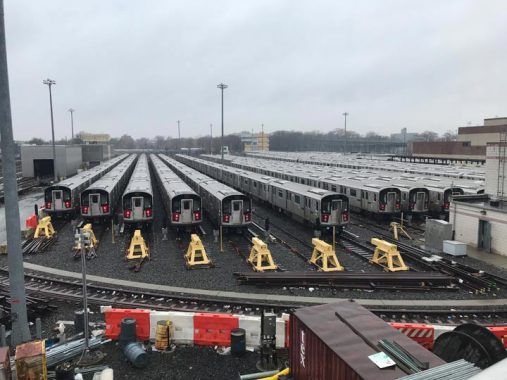
The Passerelle Boardwalk over the Corona Yards connects the LIRR Mets-Willets Point station to both Citifield and also goes into Flushing Meadows-Corona Park and Arthur Ashe Stadium. Passerelle is a French name for a walkway. Today, the yard was full of R142/R 188 (which are renovated R 142) subway cars first introduced in 2003.

I obtained this shot from the boardwalk in 1999 during a Long Island RR “fan trip” in which an engine pulled a consist of passenger cars on the Port Washington branch, which usually didn’t frequent these electrified tracks. At the time, these passenger cars were being phased out as new electrified double-decked cars were being introduced for lines without electrified tracks. After stopping here, the consist returned to Sunnyside Yards and switched tracks to the LIRR Main Line and visited locales out east.
In this shot we can also see that the Corona yards were servicing R33/36 “redbird” cars that were retired in 2003. The Flushing Line then employed R-62 and R-62A cars, first introduced in 1982, while R-142s were gradually introduced. Today, R-62/R-62As remain the workhorses of the #1, 3 and 6 trains.
On the platform, fluorescent lamps were still in use. They were switched out for brighter LED lamps in the 2000s.

In my opinion, the Mets-Willets Point station really should be a crown jewel in the LIRR tiara, but the MTA doesn’t see it that way. It is the gateway to: Citifield; the USTA Billie Jean King National Tennis Center and Arthur Ashe Stadium; and Flushing Meadows-Corona Park and its World’s Fair tradition of 1939/1940 and 1964/65. The symbol of Queens, the stainless steel Unisphere, is nearby. In early 2021, the station was a vital link to the vaccination center at Citifield.
Instead it is a nondescript metal shed. Wheelchair-bound and otherwise disabled individuals cannot use it; they need to take their chances with the elevators at Woodside or Flushing-Main Street and take the #7 train to get to Citifield or the tennis center. The staircases, at least in March 2021, were rusting and had salt accumulation from winter storms.
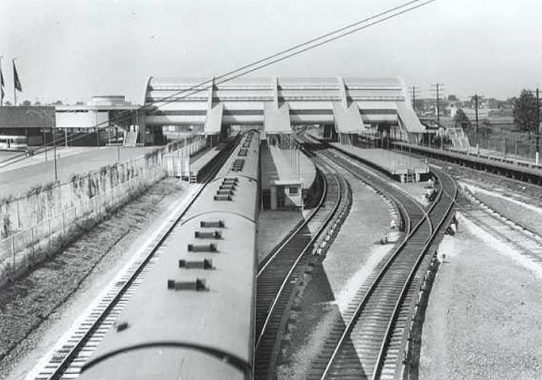
The Mets-Willets Point station is actually the newest of any of the stations on the Port Washington branch; it opened in 1939, when the first World’s Fair did. It was built with two platforms, as extra service was added for Fairgoers, and also had a futuristic-looking canopy covering the entrance on the Passerelle Boardwalk. The present station is relatively new and was constructed expressly for the 1964-65 Fair (see Comments below)

After the Fair closed, Flushing Meadows was developed into a public park and venues such as the New York State exhibit house were retained. The latter actually became a temporary HQ for the United Nations and the station was named for it between 1946 and 1952. In 1961 the station was again named for the World’s Fair; both the Fair and Shea Stadium opened in 1964, and the station stop named for the Stadium in 1966.

When Shea Stadium closed at the end of the 2008 season (a disappointing one for Met fans, as they were eliminated from playoff position with a loss to the Florida (Miami) Marlins), signage was changed to Mets-Willets Point. This sign, at 62nd Street off Woodside Avenue, is the last Shea Stadium sign still in place.
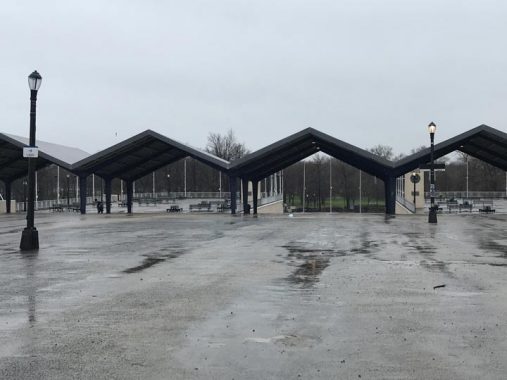
Looking south from the station entrance, this peaked gateway dates back to the opening of the Worlds’s Fair in 1964.
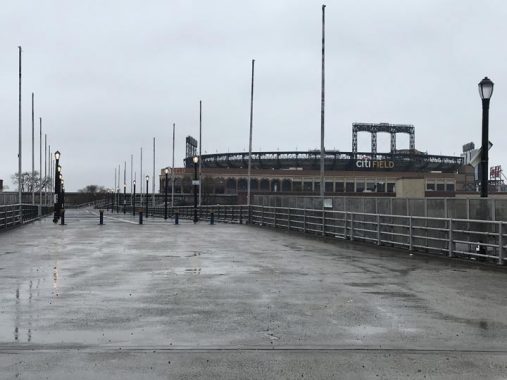
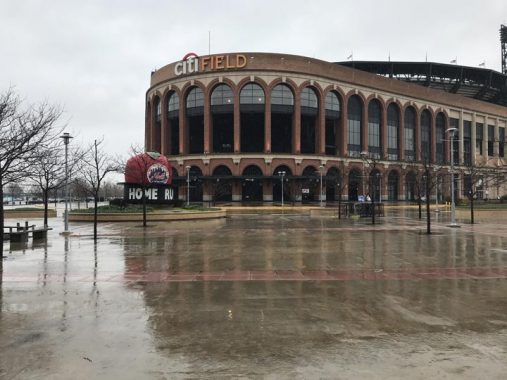
Formerly, Shea Stadium was directly in front of you as you crossed the Corona Yards. Citifield was constructed from 2007-2009 just east of it.
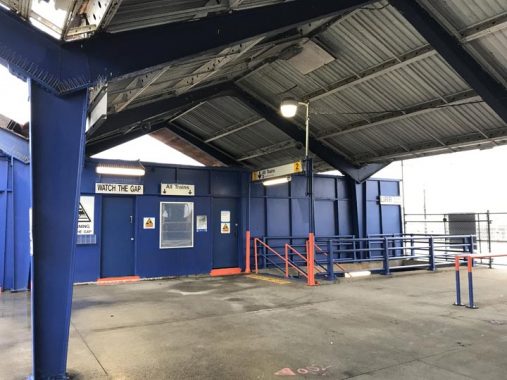
Mets-Willets Point is painted on occasion in Mets blue and orange. The entrance steps go to both Penn and Port Washington-bound trains on the center platform (along the branch, only Auburndale and Mets-Willets Point have a center platform).
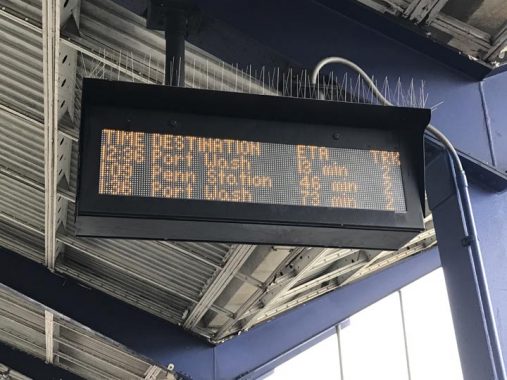
From March through at least May, infrequent service is the rule on the Port Washington. The LIRR severely slashed service due to budget cuts and diminished ridership during the Covid Pandemic; service was largely restored on other branches when the federal government coughed up some cash in a Covid relief bill. However, service will remain abysmal on the Port Washington through May 2021, the MTA says, because of a rail tie replacement program (which had been long overdue, in any case). This will be troublesome as the Mets have begin permitting partial crowds for games.

Just the basics: the sign points to the USTA Billie Jean King National Tennis Center.

The just-the-basics theme continues on the platforms, but at least there are plastic rain sheds.
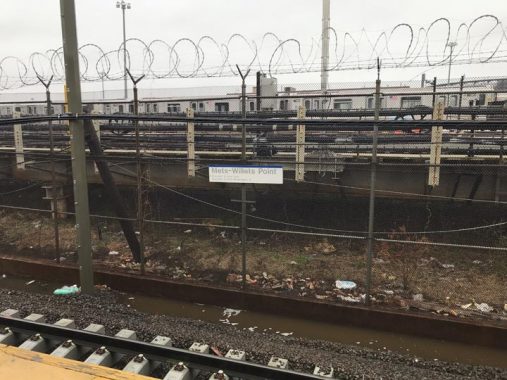
People waiting for trains see a lot of barbed wire here. I see the need to protect the Corona Yards against vandals and would-be terrorists, but I’d erect an opaque fence in front of the barbed wire for esthetic purposes.
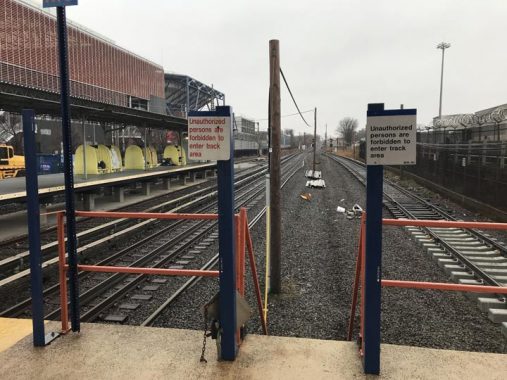
The public is of course enjoined from walking the tracks. However I frequently see LIRR personnel debarking the train and making their way to a facility at the west end of the platform. Unless I’m wrong (say so in Comments) they have to carefully pick their way across two live trackways and two third rails.

A look from the west end does give passengers a look at some real railroading. In 1915, the Pennsylvania Railroad, which then operated the LIRR, instituted a position-light signaling method consisting of nine lights on a circular mount. Turning on various lights on the mount told train operators how or if to proceed. The Baltimore & Ohio and other railroads later adopted the method. This arrangement of lights indicates a full stop.
This page gives a comprehensive view of position signals.

A curio of the Mets-Willets Point station is the presence of an unconnected trackway seen from the east end of the platform, a last remnant of the LIRR Whitestone Branch, which served College Point and Whitestone until 1932. The LIRR offered to sell the tracks to NYC for use as a subway line (which would likely transfer from the Flushing Line) but the city balked amid the Depression. A frequent refrain for NYC subway buffs is “oh what could have been, and oh what still could be.”
A short-lived RR, the Central Railroad of Long Island, also branched southeast from here between 1872 and 1879; much if its right of way in Queens is now occupied by Kissena Corridor Park.
Mets-Willets Point is not actually located in Willets Point, which is actually a few miles away in Fort Totten. The station is named for Willets Point Boulevard, a diagonal street running through the heart of the Iron Triangle. Much of it has been closed, at least temporarily, in 2021.
Whither this neglected station? Plans have been announced to make it part of the NY-NJ Port Authority AirTrain system, already in existence at Newark and Kennedy Airport. The plan, championed by Governor Andrew Cuomo, would build a massive AirTrain terminal here, with the monorail running along the Cross Island Parkway to La Guardia Airport. This plan would finally add elevators and escalators to the station at last; however, it’s been criticized for impracticality and cost by some transit advocates.
The impractical arguments come because it would force flyers and their luggage onto already overburdened #7 trains and on the LIRR, which, as shown above, is run even more inconsistently then ever. The Port Washington is separate from other LIRR branches, and from other points on Long Island, a flyer would have to travel west to Woodside, board a PW branch train there and take it to Mets-Willets Point.
Another solution exists as an addition to the AirTrain project or as an alternative: extending the N train from Astoria along Grand Central Parkway or through the Astoria Con Ed plant and then along 19th Avenue to LGA, but such plans have never materialized because of politics and money.


There may have been another means of getting people to LGA by mass transit, had it been allowed to continue: The IND World’s Fair Line, which ran for just two years, 1939-1940, along the east end of Flushing Meadows Park and just west of Cedar Grove and Mount Hebron Cemeteries.

The line’s route can be traced along the dotted line east of the Park on this 1941 Gousha map. It connected to the 71st-Continental stop, serving today’s E, F, M and R trains, and ended at a station at Horace Harding Boulevard, today’s Long Island Expressway, just west of the entrance to Mount Hebron Cemetery. It could have been extended north to LGA, but NYC’s traffic czar Robert Moses had other ideas: the Van Wyck Expressway now occupies the real estate where the subway extension used to run. The subway also could have served the Queensboro Hill community south of the LIE. The line also did not match construction specifications of other routes.

Again, the familiar refrain: “oh, what coulda been.”
Check out the ForgottenBook, take a look at the gift shop, and as always, “comment…as you see fit.” I earn a small payment when you click on any ad on the site.
4/4/21


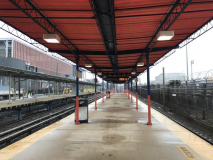


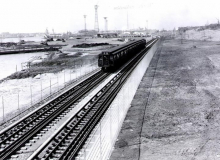
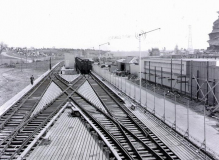
17 comments
The “Passerelle” ramp was given it’s fancy name for the 1939 NY World’s Fair maps. The word passerelle is a French word that means “footbridge” or “gangway.”
The engine in the 1999 photo is a GP38-2 with Pullman push-pull coaches.
As far as I know the IND World’s Fair line was never intended to be permanent and as a result wasn’t built sturdily enough to last.
May I add a few items noted to this excellent posting. I’ve been using this station since 1964, so I’m totally familiar with it.
Most important is that the 1939 station (the photo with the four platforms and large overpass) was razed after that Fair ended in October 1940. When the United Nations used the NYC Building (today’s Queens Museum) in the years right after World War II, a temporary wooden station was built at the approximately the same location, and it appropriately dubbed “United Nations.” As noted, it closed in 1952 and then was razed as well.
The current LIRR station was built brand new for the 1964-65 Fair and is slightly east of the 1939-40 platforms. I remember it well, as I lived on the PW Branch in those days. It is basically unchanged since then; it is connected to a rebuilt Passerelle Boardwalk that was originally installed to connect the IRT subway with the 1939-40 fair (the LIRR station had a separate entryway then). For the 1964-65 Fair and ever since, both LIRR and subway customers funned into the Fair and park through the peaked gateways that originally covered the turnstiles where Fair tickets were collected. Of course, that still makes it the newest of any of the stations on the Port Washington Branch.
The two signal aspects shown in the photo are stop signals, which cannot be passed under any circumstances. Three vertical lights without any other lamps lit is the opposite – a clear signal.
The proposal to build a LaGuardia AirTrain between the LIRR/#7 here and the airport is, in my professional opinion, a poor and wasteful proposal. There is no way to reach any other LIRR branch except by transferring at Woodside. The current Q70 bus, which serves subway and LIRR stations at Jackson Heights and Woodside, is a far better alternative right now because it operates westward and allows connections to five subway routes and all LIRR branches. Given the current NY State budget issues, it should be scrapped immediately. Just make the Q70 free and run the buses more often.
Finally, the key reason for abandoning the IND subway World’s Fair spur after 1940 was that the roadbed was not built on a permanent foundation in the swampy ground where it was located. A long-forgotten fact is that the IND World’s Fair trains charged ten cents, not the nickel on the IRT-BMT Flushing Line. Arriving passengers paid an extra nickel before leaving the World’s Fair station; departing ones paid ten cents before boarding. One of those ten cent turnstiles is preserved at the NY Transit Museum in Brooklyn. It was a similar double fare setup to the IND Rockaway Line between 1956 and 1975.
The signal indication you got a photo of means “stop”, or ”do not proceed “
I lived in Queensborough Hill from 1984-91 & then 2000-2005. It’s a post WW2 community & it’s composed primarily of one & two-family houses that were built from 1950 onward. As such every home had a detached garage. The Van Wyck & LI expressways made the community possible. There was no need for a subway extension. The community was well served by the IRT No. 7 line which was easily accessed by MTA bus service which could be easily rerouted if necessary. It was a very nice place to live because the municipal government left well enough alone.
Looks like that CitiField stadium is trying to ape the look of the old Ebbetts Field but we’re
onto them.
Re: “Looks like that CitiField stadium is trying to ape the look of the old Ebbetts Field but we’re
onto them”
I’m always amazed that we tear down the old (classic?) to build the new which imitates the old. When Shea was torn down it was the third oldest stadium in MLB and had significant history. But it was taken down for a faux historic Ebbets/Citifield. The Citifield relationship to Jackie Robinson, although well meaning, is also a stretch.
Respectfully, I must disagree with Ron S. that the “Citified relationship to Jackie Robinson…is a stretch.” As a seven-year old attending my first games at Shea in 1968 with my grandfather and uncle–both NYPD emergency service officers–I remember the introduction on the field of Roy Campanella in his wheelchair, as well as other former Brooklyn Dodgers being closely associated with the team. I had little inkling yet of the history behind their connection, other than the Dodgers had at some point before I was born left Brooklyn. I was a Queens kid and didn’t know yet about NL baseball in NYC other than the Mets. I just knew that when the Dodgers or Giants were in town we always made it to at least one game. I didn’t know about Bill Shea, who would later be very generous to the widows and families of slain NYPD officers; I didn’t know about the Paysons, or what went into the formation of our franchise. In 1968 I remember it was Mickey Mantle’s final season, but the Yankees were far from their past glories. I would only see hints watching Yankees Old Timers Days. They seemed to be heavy of history, but not as exciting in that moment of baseball time as the Mets. I watched the news at my grandfather’s knee and saw the strife roiling the nation. It would only be later I would learn of the great Jackie Robinson, who “broke the color barrier.” As a sheltered, white kid from northeast Queens, what did I know about anything? As time went on, I read and learned the history, the social and cultural history, as well as the baseball history. For some it was Ken Burns and his baseball series, but by then I already appreciated Branch Rickey and Jackie and Pee Wee and those “boys of summer,” especially the late, great Gil Hodges. But Jackie more than earned his place as part of the Mets story. Regardless of the former owners desires to recapture the past, the prominence of Jackie Robinson when one enters CitiField is earned. It could have included Willie Mays, too. I remember attending his night at Shea. But without Jackie first, hand-selected by Mr. Rickey for the reasons that have been well-documented, baseball might have been much slower to evolve. Why should the LA Dodgers own that legacy without the NL fans in NY sharing in the memories? He can’t be separated from the Mets history, even though he wasn’t a member of the team. How different would have been the paths to major league baseball for Tommie Agee, Cleon Jones, Ed Charles, and all the others?
No, it’s not a stretch, in my opinion, not in the least.
First, I have to correct Redstaterefugee. Queensboro Hill is NOT a post-WW II community. While there are parts of it that were built that late, like the section near the cemetery, the core of the community was built in the 1920s. That includes the house I’ve lived in continuously since 1956 on Booth Memorial Avenue (the former North Hempstead Turnpike and, before that, Ireland Mill Road).
Secondly, I have to thank you, Kevin Walsh, for correctly pointing out that the station is on Willets Point Boulevard and nowhere near the Long Island Sound coast location of the actual Willets Point. It drives me crazy that “Willets Point” has accidentally become the name of this neighborhood. It makes no sense, yet there’s apparently nothing to be done about it. It should actually be called something like “East Corona.”
Point well taken: the Queensboro Hill Community Church (I was a member for a few years) is on the north side of the LIE & I lived on the south side. The hill & the expressway were formidable barriers &, obviously, it shaped my perception. However, during the times I lived there I noticed that most residents were very loyal & it wasn’t unusual for two or even three generations of Queensborough Hill families to remain there.
I remember going to that station as a young youth (yoot) to see the Mets, US Open and the World’s Fair (64-65). It was exciting to take the train out from Manhattan with my uncle or older brother.
I will be sad if (when) this station is modernized. Between those peaked entry sheds, and the “futuristic” resin canopies, and other features, it has some of the last “fab 60’s” vibes from the Worlds Fair….
What’s with the “Watch the Gap” sign over the door. I thought was used where the train car edge was far from the platform for various reasons?
Mets-Willets Point is not actually located in Willets Point, which is actually a few miles away in Fort Totten.
This is a factually incorrect statement
It is correct
Here’s an interesting trivial connection between some of the above comments. “Passerelle,” as in the Boardwalk, sounds very close to “Passarella.” Art Passarella was a famous and colorful MLB umpire in the 1940s and early 1950s. Part of his fame (or notoriety?) was his infamous blown call in the 1952 World Series. With the series tied at 2-2 and Game 5 tied in the bottom of the 10th, Yankees pitcher Johnny Sain appeared to help his cause by hitting a clean single. But Passarella shockingly called him out, even he clearly beat the throw. Even worse, the Dodger 1st baseman’ had his foot off the bag! This was a huge break for Brooklyn, as they held the Yankees scoreless in the 10th and went on to win the game by scoring on the top of the 11th, to take a 3-2 lead in the series (although they ended up losing the last 2 games and the Series).
OK, so who was the Brooklyn 1st basement on the play? Gil Hodges, Dodger hero and future god to Mets fans, many who would pass through the Willetts Point station on the way to see him lead the 1969 Miracle Mets! And who was the 2nd baseman who fielded the ball and made the throw to 1st? Jackie Robinson, of course!